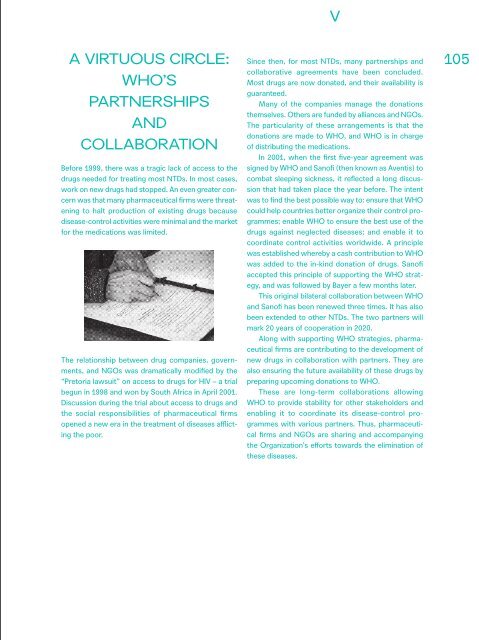Create successful ePaper yourself
Turn your PDF publications into a flip-book with our unique Google optimized e-Paper software.
V<br />
A VIRTUOUS CIRCLE:<br />
WHO’S<br />
PARTNERSHIPS<br />
AND<br />
COLLABORATION<br />
Before 1999, there was a tragic lack of access to the<br />
drugs needed for treating most NTDs. In most cases,<br />
work on new drugs had stopped. An even greater concern<br />
was that many pharmaceutical firms were threatening<br />
to halt production of existing drugs because<br />
disease-control activities were minimal and the market<br />
for the medications was limited.<br />
The relationship between drug companies, governments,<br />
and NGOs was dramatically modified by the<br />
“Pretoria lawsuit” on access to drugs for HIV – a trial<br />
begun in 1998 and won by South Africa in April 2001.<br />
Discussion during the trial about access to drugs and<br />
the social responsibilities of pharmaceutical firms<br />
opened a new era in the treatment of diseases afflicting<br />
the poor.<br />
Since then, for most NTDs, many partnerships and<br />
collaborative agreements have been concluded.<br />
Most drugs are now donated, and their availability is<br />
guaranteed.<br />
Many of the companies manage the donations<br />
themselves. Others are funded by alliances and NGOs.<br />
The particularity of these arrangements is that the<br />
donations are made to WHO, and WHO is in charge<br />
of distributing the medications.<br />
In 2001, when the first five-year agreement was<br />
signed by WHO and Sanofi (then known as Aventis) to<br />
combat sleeping sickness, it reflected a long discussion<br />
that had taken place the year before. The intent<br />
was to find the best possible way to: ensure that WHO<br />
could help countries better organize their control programmes;<br />
enable WHO to ensure the best use of the<br />
drugs against neglected diseases; and enable it to<br />
coordinate control activities worldwide. A principle<br />
was established whereby a cash contribution to WHO<br />
was added to the in-kind donation of drugs. Sanofi<br />
accepted this principle of supporting the WHO strategy,<br />
and was followed by Bayer a few months later.<br />
This original bilateral collaboration between WHO<br />
and Sanofi has been renewed three times. It has also<br />
been extended to other NTDs. The two partners will<br />
mark 20 years of cooperation in 2020.<br />
Along with supporting WHO strategies, pharmaceutical<br />
firms are contributing to the development of<br />
new drugs in collaboration with partners. They are<br />
also ensuring the future availability of these drugs by<br />
preparing upcoming donations to WHO.<br />
These are long-term collaborations allowing<br />
WHO to provide stability for other stakeholders and<br />
enabling it to coordinate its disease-control programmes<br />
with various partners. Thus, pharmaceutical<br />
firms and NGOs are sharing and accompanying<br />
the Organization’s efforts towards the elimination of<br />
these diseases.<br />
105


